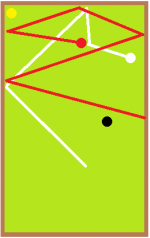Can you name any other mirrored reactions between the cue ball and object ball?
The point wasn't the opposite spin is significant, the object ball simply has an opposing reaction...... like a mirror in this analogy.
This comes up in banking shots, however, there's more to it than just spin, there's other things that are mirrored as well.
Can you name any other mirrored reactions between the cue ball and object ball? How about life, isn't our perception of reality actually a mirror?

I don't know of or believe in "overspin". "put under-spin on the cue ball, it puts over-spin on the object ball" according to CJ's first post. Although I admire his accomplishments.
I believe it was Dr Dave who tried to measure "overspin" and it was proven to be an insignificant object ball action. Mitch
The point wasn't the opposite spin is significant, the object ball simply has an opposing reaction...... like a mirror in this analogy.
This comes up in banking shots, however, there's more to it than just spin, there's other things that are mirrored as well.
Can you name any other mirrored reactions between the cue ball and object ball? How about life, isn't our perception of reality actually a mirror?

